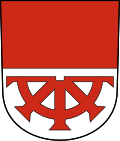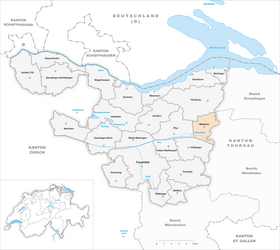Muellheim TG
| TG is the abbreviation for the Canton of Thurgau in Switzerland and is used to avoid confusion with other entries of the name Müllheim . |
| Muellheim | |
|---|---|
| Country: |
|
| Canton : | Thurgau (TG) |
| District : | Frauenfeld |
| Postal code : | 8555 |
| BFS no. : | 4831 (Political Community) |
| former BFS no .: | 4832 (local parish ) |
| UN / LOCODE : | CH MLL |
| Coordinates : | 717417 / 273314 |
| Height : | 413 m above sea level M. |
| Area : | 8.74 km² (Polish municipality) 8.01 km² (local municipality) |
| Residents: | 2991 (December 31, 2018) |
| Population density : | 342 inhabitants per km² |
| Website: | www.www.muellheim.ch |
|
Evangelical church with half-timbered houses |
|
| map | |
Müllheim , Swiss German Muele is a municipality and a town in the district of Frauenfeld of the canton of Thurgau in Switzerland . The municipal community of Müllheim merged in 1967 with their local communities of Müllheim and Langenhart to form the unitary community of Müllheim.
geography

Müllheim is located in the Thur Valley near the Grüneck motorway triangle , the Swiss Autobahn 7 and, together with Wigoltingen, has a train station on the Winterthur – Romanshorn railway line . After Steckborn on the Lower Lake Constance in the north is about 10 km, Konstanz on Lake Constance in the northeast is about 19 km away. Neighboring communities are Pfyn and Homburg TG in the Frauenfeld district, Raperswilen in the Kreuzlingen district and Wigoltingen in the Weinfelden district .
history

The municipality came under the rule of the Reichenau monastery as early as the 9th century . The village was first mentioned in a document in 1254 as Mulhain . The ministerials of Müllheim are mentioned in the 13th and 14th centuries. The Counts of Kyburg and their successors, the Habsburg-Neukyburg , exercised the umbrella bailiff in Müllheim . On September 5, 1445, the Confederates burned the village down. The umbrella bailiwick was bought back in 1460 by the Reichenau Abbey. The abbey and from 1540 to 1798 its legal successor, the Bishop of Constance , were court lords and landlords . An opening dates from the year 1475. By 1798, Müllheim elected three mayors, namely a cellar, a Seckel and a Thurmeister. The community had the right to impose fines and light corporal punishment. In 1967 the unified community of Müllheim was created through the union of the local communities of Müllheim and Langenhart.
In terms of church, Müllheim was initially part of Pfyn and was established as a parish when the St. Verena church was built around 1340. Langenhart and until 1483 Hüttlingen belonged to the parish . In 1528 the Reformation took place in Müllheim . In 1540 the rights of the collatures passed to the Bishop of Constance . In 1804 the collature went to the Canton of Thurgau and in 1830 to the parish . 1607 the Catholic Mass was reintroduced, and the Church of St. Verena was from then on until the construction of the Catholic Church of St. Mary in 1967 as parity interdenominational church used by both denominations. In the course of the 20th century, the proportion of Reformed people in Müllheim fell sharply and at the turn of the 21st century still comprised around half of the population.
In 1800 the municipality allowed the purchase of grazing rights. In Müllheim, arable, wine, fruit, flax and hemp cultivation as well as forestry and dairy farming were operated with a cheese dairy. Müllheim owned handicrafts and restaurants as well as two annual markets. The Müllheim-Wigoltingen railway station, opened in 1855, favored the establishment of the Grüneck canvas factory in 1857 . In 1979 the weaving mill Grüneta AG was founded, which went bankrupt in 2004. The tool factory Utilis Müllheim, founded in 1870, became a public limited company in 1915 and in 2000 employed 40 people. Furthermore there was u. a. 1900 embroidery, 1909 to 1916 a turnery and 1906 to 1909 a machine factory. One company has been manufacturing steel furniture since 1954, and another has been recycling industrial waste since 1991. Service companies have replaced the craft on the traffic axes with through traffic. Single-family house zones are spreading and leading to local conflicts regarding the neighborhood streets.
→ see also the history section in the Langenhart TG article
→ see also Grüneck TG article
coat of arms
Blazon : Divided of red and white half-red mill wheel .
Talking coat of arms in the colors red and white, reminiscent of the Reichenau Abbey, whose jurisdiction was Müllheim.
population
 |
| 1831 | 1850 | 1860 | 1870 | 1900 | 1910 | 1950 | 1960 | 1980 | 1990 | 2000 | 2010 | 2018 | |
|---|---|---|---|---|---|---|---|---|---|---|---|---|---|
| Political community | 2676 | 2980 | |||||||||||
| Unified Church | 1541 | 1888 | 2398 | ||||||||||
| Municipal parish | 873 | 1144 | 904 | 1464 | 1409 | 1541 | 1511 | ||||||
| Local parish | 863 | 783 | 1061 | 821 | 1397 | 1343 | 1486 | 1475 | |||||
Of the total of 2980 inhabitants in the municipality of Müllheim in 2018, 512 or 17.2% were foreign nationals. 1153 (38.7%) were Protestant Reformed and 765 (25.7%) were Roman Catholic.
economy
In 2016, Müllheim offered 895 jobs (converted to full-time positions). 5.2% of these were employed in agriculture and forestry, 42.3% in industry, trade and construction and 52.5% in the service sector.
Personalities
Johann Wepf , the composer of the Thurgau song, was born in Müllheim in 1810 . A plaque on the house where he was born commemorates the deserving citizen of the community.
Thomas Bornhauser was a Protestant pastor in Müllheim from 1851 to 1856. His gravestone is on the south wall of the Protestant church.
Attractions
In the center of Müllheim, especially around the reformed church, there are numerous well-preserved half-timbered houses from the 19th century.
The village of Grüneck in the Thur foreland between Pfyn and Müllheim consists of around 50 single-family houses that the weaving mill Grüneck built for its workers. The weavers' settlement in Grüneck is listed in the inventory of places worth protecting in Switzerland .
literature
- Alfons Raimann, Peter Erni: The art monuments of the Canton of Thurgau, Thurgau VI. The Steckborn district. Edited by the Society for Swiss Art History GSK. Bern 2001 (Art Monuments of Switzerland, Volume 98). ISBN 3-906131-02-5 .
Web links
Individual evidence
- ↑ a b Thurgau in figures 2019 . On the website of the Statistical Office of the Canton of Thurgau (PDF file; 1.8 MB), accessed on April 28, 2020.
- ↑ Swiss land use statistics. Completed on July 1, 1912. Published by the Federal Statistical Bureau. ( Memento from April 12, 2016 in the Internet Archive )
- ↑ Permanent and non-permanent resident population by year, canton, district, municipality, population type and gender (permanent resident population). In: bfs. admin.ch . Federal Statistical Office (FSO), August 31, 2019, accessed on December 22, 2019 .
- ↑ Müllheim on ortsnames.ch (online database), accessed on February 15, 2020
- ↑ a b Localities and their resident population. Edition 2019 . On the website of the Statistical Office of the Canton of Thurgau (Excel table; 0.1 MB), accessed on April 28, 2020.
-
↑ a b c d e f g h Erich Trösch: Müllheim. In: Historical Lexicon of Switzerland .
These sections are largely based on the entry in the Historical Lexicon of Switzerland (HLS), which, according to the HLS's usage information, is under the Creative Commons license - Attribution - Share under the same conditions 4.0 International (CC BY-SA 4.0). - ↑ a b story. on the website of the community of Müllheim, accessed on December 31, 2019
- ↑ a b municipal coat of arms . On the website of the State Archives of the Canton of Thurgau, accessed on December 8, 2019
- ↑ a b c population development of the municipalities. Canton Thurgau, 1850–2000 and resident population of the municipalities and change from the previous year. Canton of Thurgau, 1990–2018. On the website of the Statistical Office of the Canton of Thurgau (Excel tables; 0.1 MB each), accessed on April 28, 2020.
- ↑ Memorials in Müllheim
- ^ Paul F. Portmann: The weaving mill Grüneck AG. In: Thurgauer Jahrbuch. Volume 55 (1980), (archived in E-Periodica.ch of the ETH-Bibliothek , PDF; 2.2 MB).










